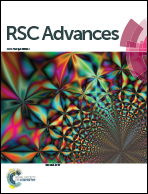Targeting a chemorefractory COLO205 (BRAF V600E) cell line using substituted benzo[α]phenoxazines†
Abstract
Mutational activations of the oncogene BRAF (especially BRAF V600E) result in a poor prognosis for colon cancer patients and are associated with chemoresistance rendering them refractory to treatment. The development of novel bioactive compounds with specific targeting abilities under such conditions is an urgent need in drug discovery. In this report we synthesize and characterize three fluorescent benzo[α]phenoxazine compounds (10R-benzo[α]phenoxazine-5-one, 1B; R = Cl, 2B; R = CH3, 3B; R = H) and their anticancer activities are evaluated in a COLO205 cell line. All three compounds with a log P value around 2 were cell permeable. However, 2B and 3B showed specific cytotoxicity in a malignant COLO205 cell line with a BRAF mutation (V600E) in comparison to a non-malignant wild-type BRAF HEK293T cell line. From further cell-based assays (cell cycle analysis, DNA fragmentation and caspase activation), we conclude that 2B and 3B treatment-induced selective cell death by inducing cell cycle arrest at the G0/G1 phase and caspase-mediated apoptosis (activation of the intrinsic and extrinsic pathways) are present only in BRAF V600E COLO205 cells. Further studies in the drug discovery pipeline might help develop these benzo[α]phenoxazines as promising chemotherapeutics for such refractory mutated cancers.
![Graphical abstract: Targeting a chemorefractory COLO205 (BRAF V600E) cell line using substituted benzo[α]phenoxazines](/en/Image/Get?imageInfo.ImageType=GA&imageInfo.ImageIdentifier.ManuscriptID=C5RA14949E&imageInfo.ImageIdentifier.Year=2015)

 Please wait while we load your content...
Please wait while we load your content...